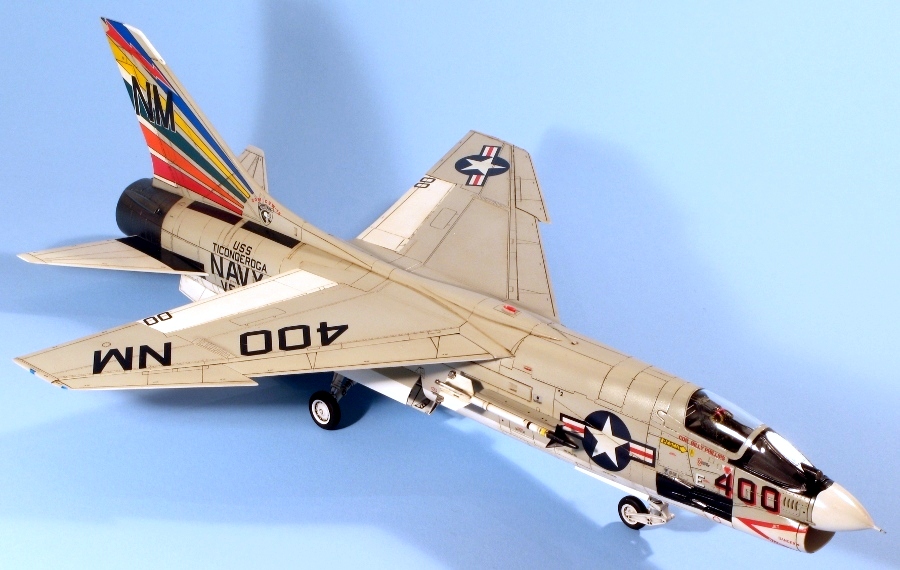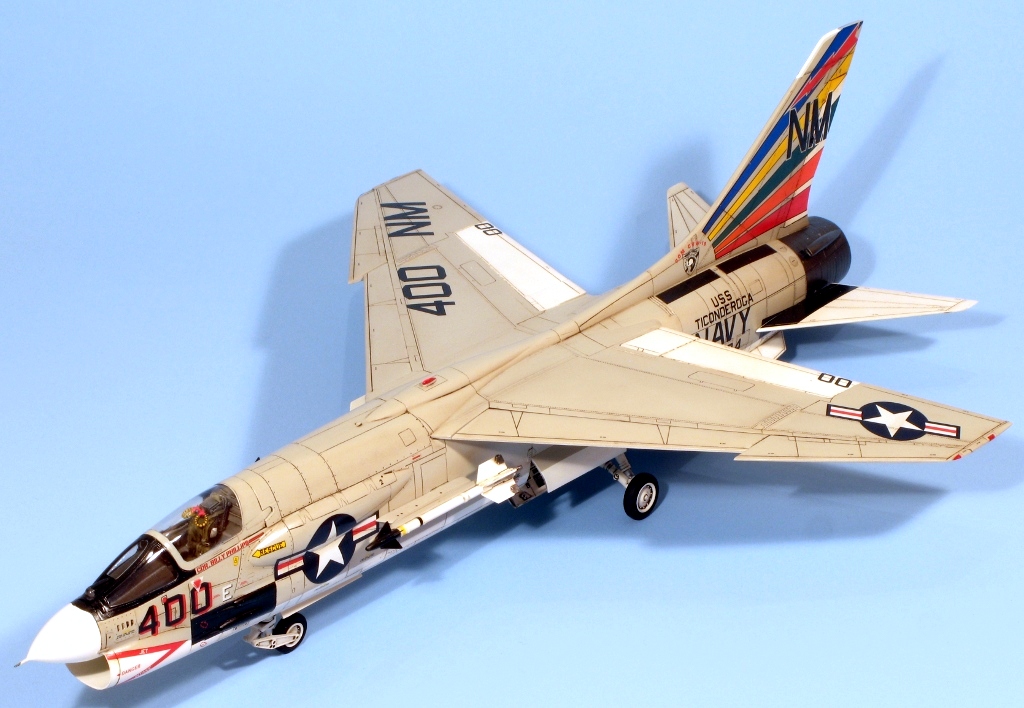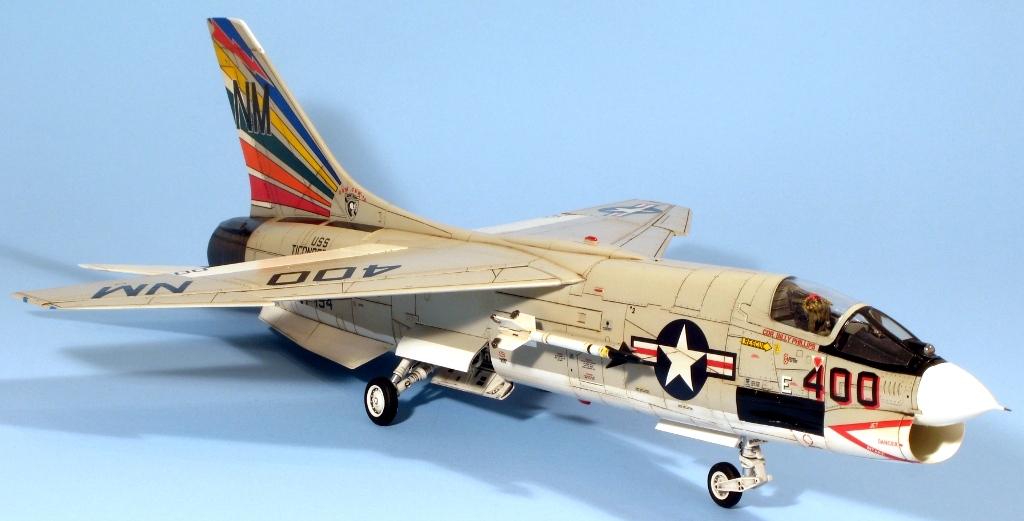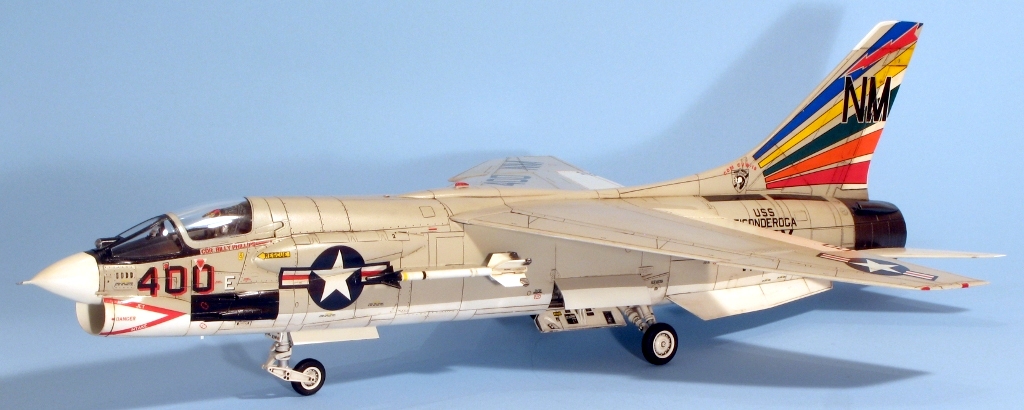with Cutting Edge resin seat
VF-194 ‘Red Lightnings’, US Navy, USS Ticonderoga 1966

One of two Hasegawa Crusaders I built at the same time (see here for the other one), and wonderful kits they are too. The engineering is fantastic and the fit very good. The kits are pretty complex though — the wing for the J model, for example, has 22 parts alone! The plastic they are moulded from is much harder than other Hasegawa kits I have built, which is both a blessing and a curse. A blessing because it seems to make seam removal better (less shrinkage of the plastic to Revell Contacta cement) and a curse because it’s hard work to sand down and polish out.
I made a number of small modifications, on the advice of F-8 experts, to enhance the accuracy of the basic kit. They are:
- Removal of the small ‘horn’ at the front of the nose landing gear.
- Modification of the burner can so that it doesn’t protrude from the rear of the fuselage.
- Replacement of the ejection seat with a resin example from Cutting Edge.
- Removal of small circular panel line under the front cockpit.
I also replaced the nose pitot with brass tube and wire. I got the dimensions a little wrong though. The sidewinders are not in the kit and come from a Hasegawa weapons set.
Overall the kit goes together very well. The air vents over the rear fuselage need to be bent to conform to fuselage curve and have their fronts drilled out. Polly caps hold the landing gear and tailerons in — great engineering. The fit of the leading edge flaps in the up position is not great, but it worked in the end. There are a lot of ejector pin marks on the wing moving surfaces, and also on the landing gear doors in very inaccessible places — I didn’t remove them as I would have lost all the interior detail as well. I used superglue as a filler and am very pleased with how well the seams have been eliminated. I must also say that the landing gear doors were attached with more ease than any other kit I have built.
As with most models, this one was not plain sailing. Buoyed by an exceptionally good construction phase, it all fell apart once I had to paint the thing. I made two fundamental mistakes: I used Humbrol enamels, and I sprayed in an unheated garage in the Winter of 2005-6. What’s the problem with Humbrol?, I hear you cry! (Especially if you’ve read of the other models I have built.) Well, they seem to have changed their formula, because they are now phenomenally translucent and do not cover. I had begun to notice this with my most recent builds, but only had to use darker colours where they problem is less (but still) apparent. The light gull grey and white scheme, however, is not as forgiving. I needed so many coats of white I obscured detail. And the light gull grey simply would not cover over the grey of the kit plastic. I have always used Humbrol 129 and 130 for my US Navy aircraft (and there are a lot that needed it), but I have never had problems like this before. More coats of paint mean more bits of rubbish (dust, small fibres, etc.) in the finish, and this has really spoiled these builds for me. I will try moving to Tamiya and Gunze acrylics (or Vallejo) on my next build.
My second mistake, airbrushing in near freezing temperatures, seemed to affect the adhesion of said Humbrol enamel. Big swatches of white, red and black were pulled up by Tamiya masking tape (never had that happen before, except with Xtracolour). I obviously could not remask, for fear of pulling up more paint, and the thought of stripping the finish was simply unacceptable, so I touched up with decals and paint. Again, a real mar on the final finish.
I used the kit decals for VF-194 ‘Red Lightnings’ (those of VF-191 ‘Satan’s Kittens’ obviously being of no interest to me). These were applied without major difficulty and settled very well using Microsol and Mr Mark Softer. The final coat was Pollyscale Satin, which is too gloss for my liking, but I have run out of matt and so, it seems, have Hannants. All the little bits were added, and here it is, a finished F-8E. Nice kit; shame about the builder’s finishing ability!


















Year bought: 2003 (HLJ, Japan)
Year built: 2006 (St Ives, Cambridgeshire)
Back to home.